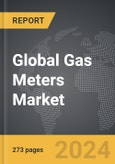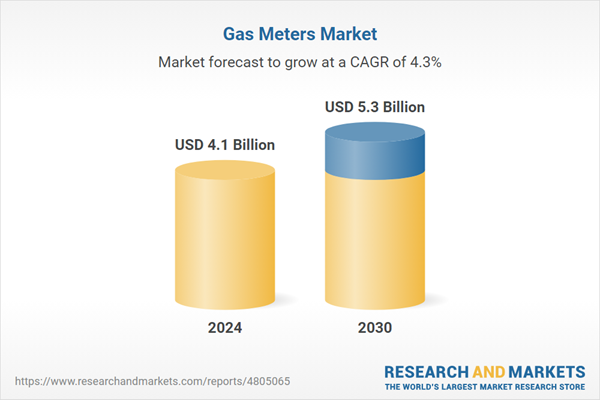Global Gas Meters Market - Key Trends & Drivers Summarized
What Are Gas Meters and Why Are They Fundamental to Modern Energy Systems?
Gas meters are devices that measure the volume of fuel gases such as natural gas and propane that flow through a pipeline. Essential to residential, commercial, and industrial energy systems, these meters facilitate accurate billing and efficient energy use by providing precise readings of gas consumption. The fundamental types of gas meters include diaphragm, rotary, turbine, and ultrasonic meters, each suited to different types of gas flow and usage scenarios. Diaphragm meters, commonly used in residential settings, measure gas volumes via the displacement of a membrane. Rotary and turbine meters, which are typically used in commercial environments, operate through mechanical means to gauge the flow of gas. On the other hand, ultrasonic meters, which employ high-frequency sound waves to measure gas flow, offer a non-mechanical and highly accurate measuring approach for industrial applications. This variety ensures that specific needs related to accuracy, flow rate, and environmental conditions are met across diverse usage scenarios.How Are Technological Advancements Shaping the Future of Gas Meters?
Technological innovations have significantly transformed the gas meter industry, enhancing both functionality and user interaction. Smart gas meters, which represent a leap in technology from traditional meters, use digital technology to provide real-time data on gas usage directly to both utilities and consumers. These meters are equipped with wireless communication technology, allowing for remote readings that eliminate the need for manual meter checks and reduce operational costs for gas companies. Additionally, smart meters facilitate detailed energy usage analytics, which can help identify inefficiencies and potential leaks, enhancing safety and sustainability. This technology is increasingly supported by Internet of Things (IoT) platforms that integrate gas meter data with other household or industrial data systems, offering a comprehensive view of energy usage and fostering more effective energy management practices.What Impact Do Regulatory and Environmental Considerations Have on the Gas Meter Market?
Regulatory and environmental factors play a crucial role in shaping the gas meter market, driving demand for more advanced metering solutions. Governments worldwide are implementing stricter regulations regarding energy efficiency and conservation, which in turn require more precise and reliable metering devices. These regulations often mandate the installation of advanced metering infrastructure (AMI) to encourage better energy management and to reduce overall energy consumption. Moreover, environmental concerns, particularly those related to greenhouse gas emissions and energy waste, are prompting utilities and consumers to adopt smarter, more efficient gas meters. This regulatory and environmental push towards sustainability is leading to the gradual replacement of older, less efficient meters with advanced systems that can support a more sustainable and accountable energy usage framework.What Factors Are Catalyzing the Growth in the Gas Meter Market?
The growth in the gas meter market is driven by several factors, including technological advancements, regulatory policies, and shifts in consumer behavior. The increasing adoption of smart home technologies has led to higher demand for smart gas meters, which are compatible with home automation systems and offer consumers real-time insights into their energy consumption. Additionally, the global expansion of natural gas infrastructure in emerging economies creates a vast demand for new installations of gas meters, which are needed to ensure accurate billing and efficient gas distribution. Regulatory frameworks across the world are also compelling utilities to upgrade their metering infrastructure to comply with new standards aimed at enhancing energy efficiency and reducing environmental impact. Moreover, the push from governments for improved air quality and reduced dependency on polluting energy sources encourages the adoption of gas over other fossil fuels, indirectly boosting the market for gas meters. These factors, combined with ongoing innovations in metering technology and data analytics, are setting a dynamic growth trajectory for the gas meter industry.Report Scope
The report analyzes the Gas Meters market, presented in terms of market value (USD). The analysis covers the key segments and geographic regions outlined below.- Segments: Type (Basic, Smart).
- Geographic Regions/Countries: World; USA; Canada; Japan; China; Europe; France; Germany; Italy; UK; Spain; Russia; Rest of Europe; Asia-Pacific; Australia; India; South Korea; Rest of Asia-Pacific; Latin America; Argentina; Brazil; Mexico; Rest of Latin America; Middle East; Iran; Israel; Saudi Arabia; UAE; Rest of Middle East; Africa.
Key Insights:
- Market Growth: Understand the significant growth trajectory of the Basic Gas Meters segment, which is expected to reach US$4 Billion by 2030 with a CAGR of 3.9%. The Smart Gas Meters segment is also set to grow at 5.8% CAGR over the analysis period.
Why You Should Buy This Report:
- Detailed Market Analysis: Access a thorough analysis of the Global Gas Meters Market, covering all major geographic regions and market segments.
- Competitive Insights: Get an overview of the competitive landscape, including the market presence of major players across different geographies.
- Future Trends and Drivers: Understand the key trends and drivers shaping the future of the Global Gas Meters Market.
- Actionable Insights: Benefit from actionable insights that can help you identify new revenue opportunities and make strategic business decisions.
Key Questions Answered:
- How is the Global Gas Meters Market expected to evolve by 2030?
- What are the main drivers and restraints affecting the market?
- Which market segments will grow the most over the forecast period?
- How will market shares for different regions and segments change by 2030?
- Who are the leading players in the market, and what are their prospects?
Report Features:
- Comprehensive Market Data: Independent analysis of annual sales and market forecasts in US$ Million from 2024 to 2030.
- In-Depth Regional Analysis: Detailed insights into key markets, including the U.S., China, Japan, Canada, Europe, Asia-Pacific, Latin America, Middle East, and Africa.
- Company Profiles: Coverage of players such as CGI, Inc., Badger Meter, Inc., Apator SA (Apator Group), Diehl Metering GmbH, Advanced Electronics Company and more.
- Complimentary Updates: Receive free report updates for one year to keep you informed of the latest market developments.
Some of the 75 companies featured in this Gas Meters market report include:
- CGI, Inc.
- Badger Meter, Inc.
- Apator SA (Apator Group)
- Diehl Metering GmbH
- Advanced Electronics Company
- Diehl Stiftung & Co. KG (Diehl Group)
- AddGroup
- Chongqing Shancheng Gas Equipment Co., Ltd.
- Dandong Dongfa (Group) Co., Ltd.
- British Gas
- China Minsen Meter Co., Ltd.
- EKM Metering Inc.
- AEM SA
- Aichi Tokei Denki Co., Ltd.
- Azbil Kimmon Co., Ltd.
This edition integrates the latest global trade and economic shifts into comprehensive market analysis. Key updates include:
- Tariff and Trade Impact: Insights into global tariff negotiations across 180+ countries, with analysis of supply chain turbulence, sourcing disruptions, and geographic realignment. Special focus on 2025 as a pivotal year for trade tensions, including updated perspectives on the Trump-era tariffs.
- Adjusted Forecasts and Analytics: Revised global and regional market forecasts through 2030, incorporating tariff effects, economic uncertainty, and structural changes in globalization. Includes historical analysis from 2015 to 2023.
- Strategic Market Dynamics: Evaluation of revised market prospects, regional outlooks, and key economic indicators such as population and urbanization trends.
- Innovation & Technology Trends: Latest developments in product and process innovation, emerging technologies, and key industry drivers shaping the competitive landscape.
- Competitive Intelligence: Updated global market share estimates for 2025, competitive positioning of major players (Strong/Active/Niche/Trivial), and refined focus on leading global brands and core players.
- Expert Insight & Commentary: Strategic analysis from economists, trade experts, and domain specialists to contextualize market shifts and identify emerging opportunities.
Table of Contents
Companies Mentioned (Partial List)
A selection of companies mentioned in this report includes, but is not limited to:
- CGI, Inc.
- Badger Meter, Inc.
- Apator SA (Apator Group)
- Diehl Metering GmbH
- Advanced Electronics Company
- Diehl Stiftung & Co. KG (Diehl Group)
- AddGroup
- Chongqing Shancheng Gas Equipment Co., Ltd.
- Dandong Dongfa (Group) Co., Ltd.
- British Gas
- China Minsen Meter Co., Ltd.
- EKM Metering Inc.
- AEM SA
- Aichi Tokei Denki Co., Ltd.
- Azbil Kimmon Co., Ltd.
Table Information
| Report Attribute | Details |
|---|---|
| No. of Pages | 273 |
| Published | December 2025 |
| Forecast Period | 2024 - 2030 |
| Estimated Market Value ( USD | $ 4.1 Billion |
| Forecasted Market Value ( USD | $ 5.3 Billion |
| Compound Annual Growth Rate | 4.3% |
| Regions Covered | Global |









